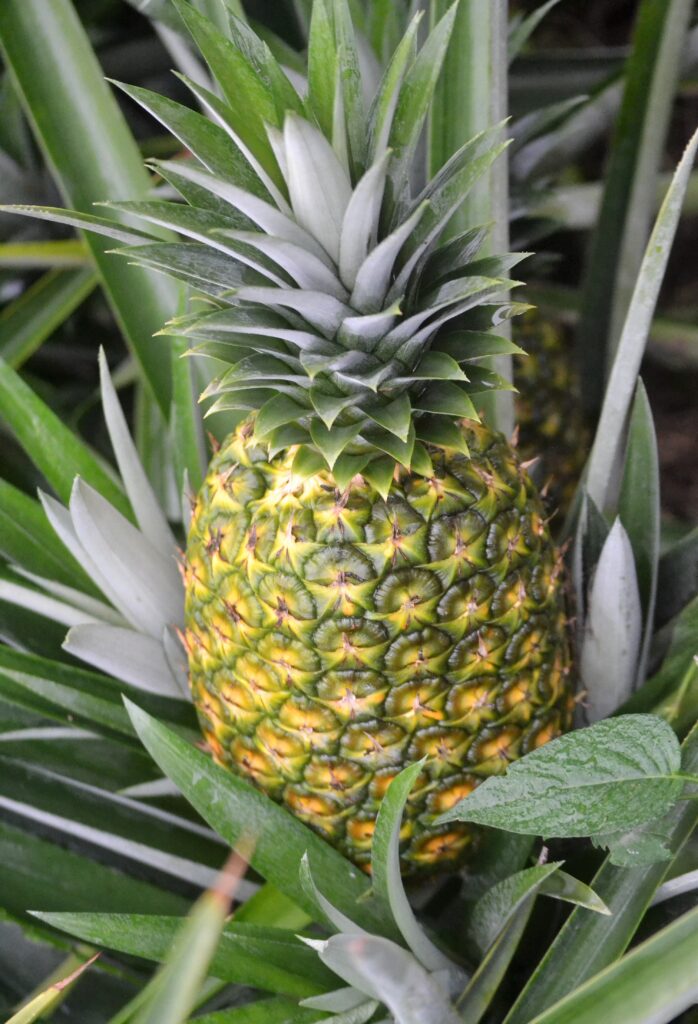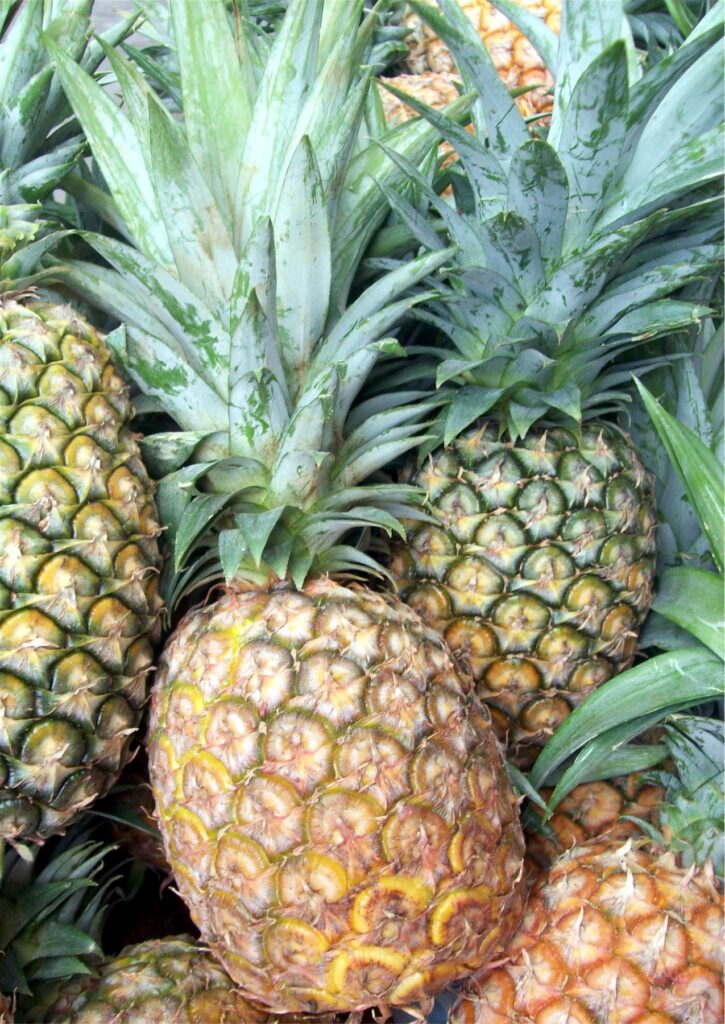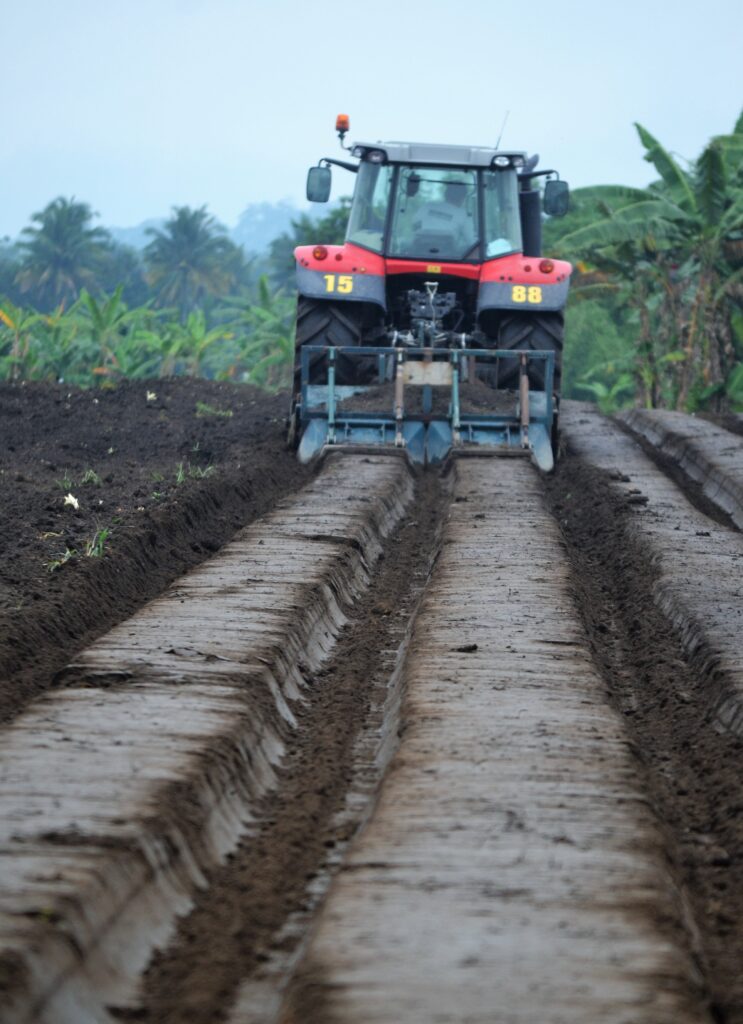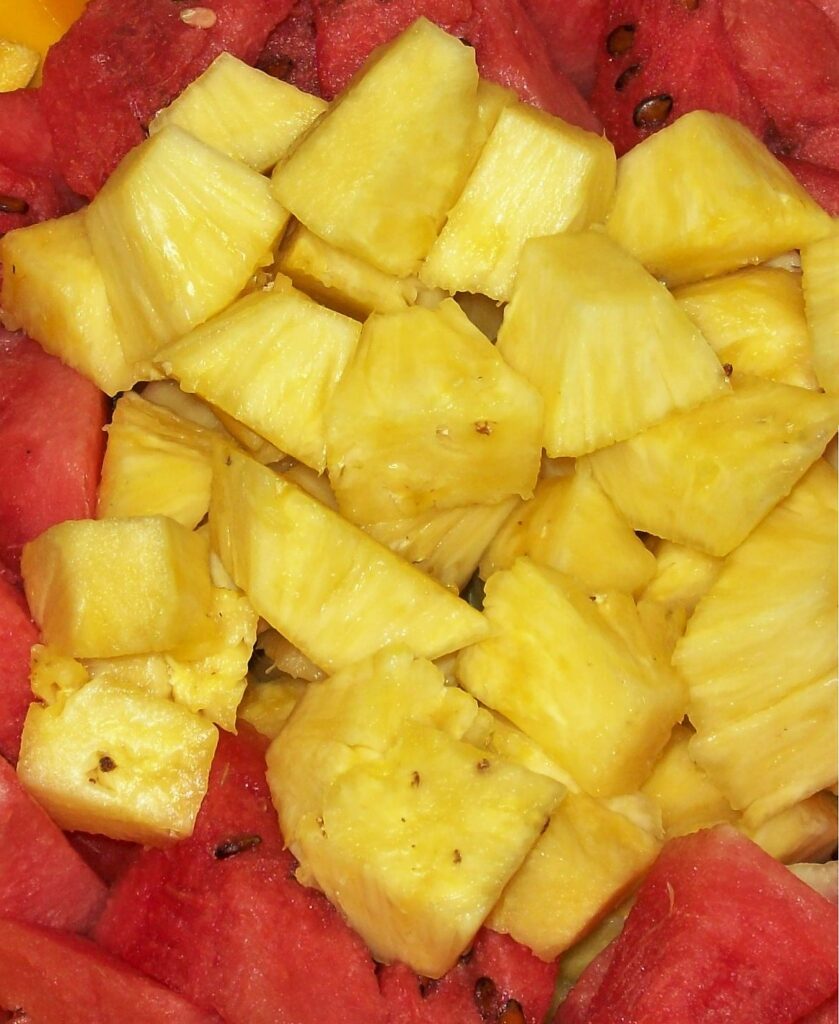Text and Photos by Henrylito D. Tacio
Next to banana, pineapple (scientific name: Ananas comosus) is the second most popular tropical fruit. It is no wonder why pineapple is grown commercially in the country. In fact, pineapple is one of the primary agricultural exports of the Philippines.
More than 75% of the country’s pineapple production comes from Mindanao, particularly Northern Mindanao and SOCCSKSARGEN (South Cotabato, Cotabato Province, Sultan Kudarat, Sarangani, and General Santos City). Other pineapples producing regions in Mindanao include Davao, Caraga, and the Zamboanga Peninsula.
Outside Mindanao, the two major producers are Bicol and CALABARZON (Cavite, Laguna, Batangas, Rizal, and Quezon). Pineapple is also grown commercially in Cagayan Valley and Central Luzon. In the Visayas, the top producers are Western Visayas, Eastern Visayas, and Central Visayas.
The Philippines ranks third in pineapple production, next to Brazil and Thailand. Pineapple is grown extensively, so much that some of the largest pineapple plantations in the world can be found in the country. Primary exporters Dole and Del Monte have an influential presence at local levels, particularly in Mindanao.
Pineapple is one of the three export fruit commodities of the Philippines; the other two are banana and mango. Interestingly, only 17% of the pineapple industry is composed of fresh fruit designated for export to Japan, South Korea, Taiwan, New Zealand, and China. But it also exports processed products mainly to the United States. Pineapples are processed into juice, jellies and jams, dried fruit, pineapple vinegar, and fruit cocktail.
“The Philippines is a top exporter of juice concentrates and pineapple juice in Southeast Asia,” the Department of Agriculture (DA) reports. “Both fresh and processed export industry is increasing in value. It is mainly produced in the Mindanao Region.”
If you’re wondering where the other percentage of pineapple produced in the country go to, here’s what the Taiwan-based Food and Fertilizer Technology Center (FFTC) said: “The bulk (41%) of the Philippine pineapple industry is dedicated to total net food and is treated as a disposable product. Another bulk (37%) of the products produced are designated for general processing, while the remaining 5% is dedicated to feed products or waste materials.”
Most of the farmers growing pineapple are actually catering to the local market. In fact, most of the pineapple plantations in the country are classified as small, with a total size of two hectares or less. A farmer who goes into pineapple growing can produce a return of P25,000 from an investment of P10,000.
Since pineapple can be grown throughout the year, harvesting is also a year-round experience. For smaller farms, the peak time for harvest is usually April through July. Generally, the suckers and slips are used as planting materials for the next cropping season.
Among the many pineapple varieties grown in the country, the Smooth Cayenne (locally called “Hawaiian”) is the most preferred locally for fresh fruit and processing. The Queen (more popularly known as “Formosa”) is also grown in some fresh fruit areas. The “Philippine Red” pineapple is cultivated not for its fruit but its strong and delicate fiber.
Although pineapple is grown in other tropical countries (particularly Thailand, China, Brazil, and Mexico), the Philippines’ pineapple industry remains vibrant. “As with any tropical fruit industry, the Philippine pineapple may experience economic downturns from time to time,” observes Brandon Gaille, an American national who conducts small business and marketing advice. “Because of the popularity of the product, however, there will always be local and international markets that are seeking to import more of this sweet fruit.”
The United States is a case in point. “If shipping methods can be improved for Philippine pineapples, the United States market could provide the foundation for tremendous growth for the industry,” Gaille writes. “The United States is the top importer of fresh pineapple, canned pineapple, plain pineapple juice, and concentrated pineapple juice. Less than 3% of Philippine pineapples designated for export ever reach the United States.”
The agriculture department has identified high demand in the world market as one of Filipino pineapple growers’ big opportunities. There is also an increasing demand for export both for fresh fruits and processed products. More importantly, there are now niche markets for organically-grown pineapple fruits.
But before doing so, first, we must address the local problems in terms of fruit production. For one, there is still an insufficient supply of quality fruits, even in the local market. For another, there are ever pests and diseases – mealy bugs, root grubs, and Phytophthora – that keep bugging the industry.
Not to mention the poor transport infrastructure facilities. Most farmers also complain that they lose 40% of their total production due to hauling, rat infestation, and damage. “We have to solve these problems if we want to be a big major player in the world market for the pineapple industry,” a farmer commented.
Some farmers also voice out the government’s lack of support in terms of financing/ credit and market assistance for small growers and processors. “How can we improve our methods and production if we lack capital?” they asked.
Pineapple grows anywhere in the Philippines, but it grows best in areas where the temperature is mild (24-30 degrees Centigrade); rainfall is between 1,000-1,500 millimeters per year and evenly distributed during the growing period; elevation is 150-240 meters above sea level, and there is full sunlight.
“The soil should be fertile and well-drained,” says the Laguna-based Philippine Council for Agriculture and Aquatic Resources Research and Development (PCAARRD). “It has a pH of 4.5-5.5 and the cultivated soil layer is not shallower than 50 centimeters.”
The land must be thoroughly prepared before planting. “Drainage canals are established whenever necessary,” PCAARRD reminds, as pineapple doesn’t grow well in waterlogged areas. Planting is immediately done after the land has been prepared.
Planting density may be as low as 33,333 plants per hectare to as high as 76,923 plants per hectare. Plants may be grown in double rows at a distance of 80-100 centimeters between double rows, 50 centimeters between rows, and 30 centimeters within rows. Planting in single rows is common among small farms, while double rows are recommended in commercial farms.
Harvesting pineapple is dependent upon what the fruit is intended for. PCAARRD shares this information: “Fruit maturity at harvest influences the quality of pineapple. Pineapple exhibits slight ripening changes after harvest. Thus, it is important to harvest pineapple at the right maturity for its intended use.”
Pineapple, unlike abaca and pili nut, is not a native of the Philippines. It is believed to have originated from Brazil, where tribal peoples have always regarded pineapple highly and have used it as a staple food and as an ingredient in some wines. When early explorers brought the pineapple back to Europe, its sweetness and unusual appearance made the fruit a symbol of royal privilege.
How pineapple gets its name is an interesting story. When Christopher Columbus came across pineapple in 1493 on the island of Guadeloupe, he called it la piña de las Indians (“the pine of the Indies”) because, as he later told Ferdinand and Isabella, they resembled “green pine cones, very sweet and delicious.” The odd name stuck, and pineapples are still called piñas in most Spanish-speaking countries. In fact, the word pineapple originally meant “pine cone” in England.
Being popular in Europe, the Spaniards (who carved pineapples over doorways) brought the fruit to the Philippines after the latter was rediscovered in 1521. For years, Hawaii supplied 70% of the world’s canned pineapple and 85% of canned pineapple juice, but labor costs have shifted a large segment of the industry from Hawaii to the Philippines.
Pineapples’ nutritional benefits are as fascinating as their history. According to Megan Ware, in an article published by Medical News Today, one cup of fresh pineapple chunk is cholesterol-free and contains approximately 82 calories. It also contains 0.2 grams of fat, 2 milligrams of sodium, 0.89 grams of protein, and 21.65 grams of total carbohydrates (including 16 grams of sugar and 2.3 grams of fiber).
As a percentage of a person’s daily requirements, the same chunk of fresh pineapple provides 131% of vitamin C, 2% of vitamin A, 2% of calcium, and 3% iron.
Pineapple is also a source of important vitamins and minerals, including thiamin, riboflavin, vitamin B-6, folate, pantothenic acid, magnesium, manganese, potassium, beta-carotene, and other antioxidants.
But most importantly, fresh pineapple is the only known source of an enzyme called bromelain, which was discovered to be proteolytic – that is, it breaks down protein. Hence it is a natural meat tenderizer (the pineapple rings atop a baked ham are not there just for the flavor) and digestive aid.
Bromelain can also break down blood clots-proteins, hold blood platelets together to form clots – and clean away the dead tissue left by burns, abscesses, ulcers, and various kinds of surgery. It also has been proven to be effective in killing parasites such as worms.
Studies have shown that bromelain in pineapples can interfere with the preparation of some foods, such as jelly or other gelatin-based desserts. The bromelain breaks down in the canning process; thus, canned pineapple can generally be used with gelatin.
Just a word of warning: Bromelain can be hazardous to someone suffering from certain protein deficiencies or disorders, such as Ehlers-Danlos syndrome. Pineapples should also not be consumed by those with hemophilia or those with kidney or liver disease, as it may reduce the time taken to coagulate a consumer’s blood.
When unripe, the pineapple is inedible but poisonous, irritating the throat and acting as a drastic purgative. Excessive consumption of pineapple cores has caused fiber balls (bezoars) in the digestive tract.
Women who want to get pregnant should not eat pineapple. In some parts of the world, the flesh of very young fruits is deliberately ingested to achieve abortion (a little with honey on 3 successive mornings).
Despite such drawbacks, pineapple has a thousand medicinal uses. In her book Food Remedies, Florence Daniel has named pineapple juice as the specific remedy for diphtheria. The sour, unripe fruit improves digestion, increases appetite, and relieves dyspepsia.
In Indian herbal medicine, pineapple is thought to act as a uterine tonic. The ripe fruit cools and soothes and is used to settle gas and reduce excessive gastric acid. Its significant fiber content makes it useful in constipation. The juice of the ripe fruit is both a digestive tonic and a diuretic. The leaves are considered to be useful in encouraging the onset of menstrual periods and easing painful ones.
Another benefit of eating pineapple is that it helps to build healthy bones. Pineapples are rich in manganese, a trace mineral needed for your body to build bone and connective tissues. The benefits of pineapple when you have a cold or cough are the same as the benefits of orange juice, as pineapple contains significant amounts of vitamin C.
Source: Edge Davao





